“Plant your seed in the morning and keep busy all afternoon, for you don’t know if profit will come from one activity or another—or maybe both.”
Ecclesiastes 11: 6 (NLT)
“Diam-diam ubi berisi – the cassava tuber grows quietly in strength.”
Malay proverb
Discover the Significance Your Work and your Corporate Values
Have you ever contemplated the purpose behind your work? Here are a few perspectives to consider:
- Impact on the Environment: Your actions can make a significant difference in mitigating phenomena like the Silent Spring, protecting our planet’s ecological balance.
- Crop Diversity: By transitioning from a sole focus on crops such as oil palm, you can embrace diversity by venturing into cassava cultivation.
What Fuels Your Company’s Core Values?
Understanding your corporation’s core values is paramount. Here are some reasons why they matter:
- Unique Investment Opportunity: Recognizing the distinctive potential of investments in cassava can enable your company to seize a larger share of the market.
- Economic Development: By emphasizing food security, you can play a vital role in fostering economic growth and stability.
When the purpose of your work aligns seamlessly with your corporation’s core values, something remarkable transpires. You become part of a mission driven by purpose, leaving a legacy that contributes to a lasting, positive impact on society.
Cassava roots
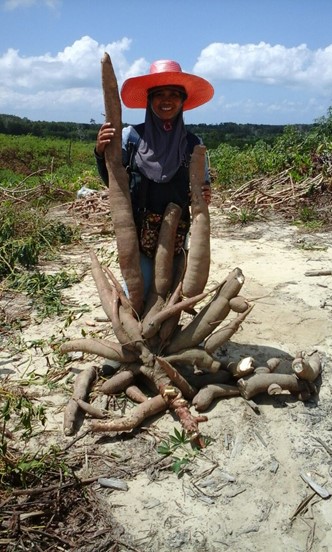
1.0 Executive Summary
Mission
The mission is to revolutionize the agricultural landscape by investing in cassava plantations encompassing a total of 288,000 hectares. The objectives include:
- Cultivating cassava and producing an impressive 4.15 million metric tons of cassava chips.
- Substituting 50% of corn imports for the thriving animal feed industry in Malaysia.
- Initiating Stage 1, involving an investment in 20,000 hectares of cassava plantation and establishing a factory to produce 288,000 metric tons of cassava chips for the animal feed industry in Sabah, Malaysia.
Key Management Team
The leadership team comprises individuals who bring immense expertise and vision to the group:
- Mentors: Distinguished pioneers and industry leaders who possess a global network and provide invaluable guidance and inspiration.
- Coaches: Mission-oriented industry experts who offer practical solutions to challenges, ensuring the team remains dedicated to its goals.
- Partners:
- A project leadership group with extensive experience in plantation management, processing, research and development, along with international exposure in the cassava industry.
- A highly regarded finance manager with access to private equity funding within the Asia Pacific agricultural sector.
- A credible local investor with land acquisition capabilities, a network of domestic animal feed millers, access to financial incentives, and government business support.
- Target animal feed millers.
Product Benefits
The offerings come with a range of advantages:
- Cost-effectiveness in production, energy tariffs, labour rates, and land.
- Rapid logistical supply, ensuring delivery within 24 hours, as opposed to imported corn.
- A competitive pricing strategy.
- Fresher, locally sourced products compared to imported feed ingredients.
- Enhanced productivity compared to other crops.
Target Market
The sales, advertising, promotions, and distribution strategies are geared toward domestic animal feed millers. The marketing and sales approach will emphasize competitive pricing against imported corn.
Financial Projections – 288,000 Hectares
• Total investment: US$576 million • Production cost: US$747 million per year • Revenue: US$1.1 billion per year • Income: US$353 million per year • Payback period: 3 years

Unique Business Model
The unique business model:
- Secure commitment from target market feed millers for the purchase of our end product.
- Strong support from the Malaysian government, championing cassava investment in Borneo to ensure food security for the animal feed industry.
- Access to funding sources with scalability for expansion.
- A robust management team with operational experience and a comprehensive network within the cassava industry.
2.0 Mission
2.1 Problem Statements
- Monocropping: Borneo Island finds itself trapped in a cycle of monocropping, primarily dominated by oil palm cultivation. This relentless focus on a single crop, year after year, within the same area, elevates the vulnerability to pest and pathogen attacks due to the accumulation of these threats. Monocropping not only poses a substantial risk to biodiversity but also hints at the potential for an environmental catastrophe, reminiscent of Rachel Carson’s prophesied “Silent Spring.”
- Animal Feed Dependency: Malaysia currently relies entirely on imported grain corn to sustain its animal feed industry. This dependence raises concerns regarding food security, prompting the need for an alternative crop source that can compete on cost-effectiveness.
2.2 Proposed Solutions
- Diversification: Embracing cassava cultivation emerges as a promising solution. Cassava presents itself as the optimal choice due to its unmatched cost-efficiency and productivity, catering to both the animal feed and starch industries.
- Abundant Land Resources: Borneo stands out as the ideal location for this venture, offering extensive, untapped land resources to support all stages of cassava-based industry operations.
2.3 Mission
Phase 1: Animal Feed
- Invest in the cultivation of 288,000 hectares of cassava to yield 4.15 million metric tons of cassava chips, a substantial replacement for corn imports.
- Initiate Stage 1 of Phase 1, involving a 20,000-hectare cassava plantation dedicated to producing 280,000 metric tons of dried chips to cater to the Malaysian animal feed industry.
Phase 2: Starch Derivatives
- In Phase 2, commence Stage 1 with an investment in the downstream industry, necessitating a 10,000-hectare cassava plantation. This will produce 90,000 metric tons of malto dextrin to meet domestic demand.
Currently, there is a noticeable absence of large-scale cassava plantations supplying raw materials to support the local animal feed industry. This mission aims to fill that void, addressing not only the need for economic diversification but also the imperative for enhancing food security in Malaysia.
3.0 Product
3.1 Product description
Cassava, also known as tapioca, is a versatile tuber crop with a wide range of applications. It serves various industries, including animal feed, food, chemicals, and energy. The cassava root can be processed into valuable starch derivatives such as malto dextrin, sorbitol, and fructose. Notably, cassava flour is gluten, grain, and nut-free. This remarkable crop stands as one of the most efficient producers of carbohydrates and energy among all food crops. A well-managed single hectare of cassava can yield up to 36 metric tons of roots, a substantial increase compared to the 10 metric tons of corn.
3.2 Product attributes
Cassava provides a quick return with harvest at the 10-12 months. The varieties Sri Kanji 1 and 2 provide the higher starch content. Cassava chip as an animal feed is popular among the local feed millers. The livestock love dried cassava chip as it offers a distinctive taste.
Cassava Plant Cassava Chip Packaging in 50kg
Poly Bag
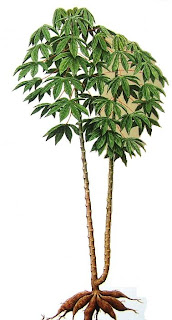
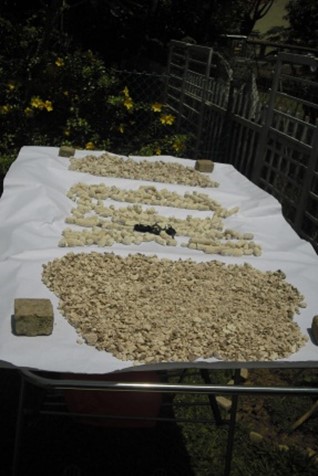

3.3 Product Benefits:
- Cost Efficiency: Cassava chips produced in Borneo Island offer a significant cost advantage, resulting in competitive pricing when compared to imported corn.
- Freshness: Local production ensures shorter logistical distances, reduced transit times, and fresher products for consumers.
- Cultivation Expertise: Local farmworkers possess knowledge and experience in cassava cultivation, simplifying the production process.
3.4 Product Competitive Advantages:
- Early Mover Advantage: The key to success lies in identifying and seizing this unique opportunity, establishing an early mover advantage by being the first entrant in the market.
- Government Support: Cassava chips contribute to food security within the animal feed sector, and the Malaysian Government is firmly committed to supporting this solution.
- Abundant Land Resources: Borneo Island offers vast expanses of land, perfectly suited for large-scale plantations, processing mills, and the development of downstream starch derivatives. This abundant land resource provides a significant competitive edge.
4.0 Market
4.1 Market Segment
1. Animal Feed: According to the USDA, Malaysia’s corn imports have exhibited a consistent upward trend:
- 2017-2018: 3.65 million tonnes
- 2018-2019: 4.00 million tonnes
- 2019-2020: 4.15 million tonnes
This increase is primarily driven by the growing demand for poultry feed. The corn import replacement market is valued at US$1.1 billion based on the 2021 price of US$268 per metric ton.
2. Maltodextrin: Malaysia consumes 90,000 metric tons of malto dextrin annually. The starch derivative industry is estimated to be worth US$69.3 million at a 2021 price of US$770 per metric ton.
4.2 Target Market Strategy
Malaysia’s animal feed market is experiencing significant growth due to population expansion and changing consumer preferences, particularly in favour of poultry. The country is a prime target market because of its urgent need for food security. Investment in Borneo, encompassing both upstream and downstream cassava root processing, is well-positioned to meet this market demand. The strategic plan involves investing in cassava cultivation and chips processing mills, as these segments offer higher margins within the value chain. Animal feed millers will further process cassava chips into pellets.
Phase two of the investment will shift focus to the production of malto dextrin for the local food industry and expansion into regional markets.
4.3 Market Needs
In 2020, Malaysia imported 4.15 million metric tons of corn, with the feed industry heavily reliant on poultry and swine, which together account for approximately 85% of feed consumption. The remaining 15% serves ruminants, pets, and sports animals.
Malaysia’s malto dextrin market demand stands at 90,000 metric tons per year. This versatile product finds applications in non-dairy creamer, caramel, maltose syrup, glucose syrup, and high fructose syrup. Currently, Malaysia imports cassava starch from Thailand and processes it into various starch derivatives, including malto dextrin.
4.4 Growth Drivers
Malaysia’s demand for cassava products is primarily fueled by several key factors:
- Population Growth: A rising population drives increased food and feed demand.
- Increasing Incomes: As incomes rise, so does consumer purchasing power and dietary diversity.
- Changing Diet: Evolving dietary preferences contribute to the demand for diversified food ingredients.
- Export Opportunities: Malaysia’s export of table eggs to other nations, including Singapore, underscores its position as a regional supplier.
4.5 Key customers
There are 45 feed mills in Malaysia. Among the top players are:
Balung Animal Feed Mill Budi Feed DBE Poultry Feedmills Dindings Soya & Multifeed FFM Gold Coin Feedmills KPFB Bersepadu KL Supreme Feedmill Leong Hup Feedmill MFM Feedmill Opf Feed Enterprise PK Agro-Industrial Products Pony Feedmills PPB Group Purnima Feeds PTS GoldKist Industries Sabah Flour and Feed Mills Soon Soon Feedmills TSK Animal Feed Volac Wilmar
4.6 Competition and Industry
- Corn Import:
- Malaysia predominantly imports its corn from South America, with roughly 80% sourced from Argentina and Brazil.
- Argentina is the largest corn exporter to Malaysia, holding over 50% of the market share, followed by Brazil and the United States.
- Yield:
- Cassava yields an impressive 36 metric tons per hectare.
- In contrast, corn typically yields around 10 metric tons per hectare.
- Land:
- Borneo Island stands out as the prime location for this endeavor, boasting extensive available land suitable for large-scale plantations. Growing cassava on this island provides direct access to the local feed-milling market.
- Leading Cassava Company:
- Currently, there is no major cassava company catering specifically to the animal feed industry in Malaysia. This presents an opportune moment to fulfill the market’s unmet needs.
- Strong Demand for Land:
- The commercial sector competes vigorously for land acquisition, primarily for oil palm plantations.
- However, the Malaysian Government places a high priority on food security for both the animal feed and starch industries. Consequently, it is expected to provide robust support for large cassava plantations aimed at serving the animal feed sector.
- Industry:
- Global Cassava Production and Trade
Global Cassava Production and Trade

Source: Krungsi Research, Sowcharoensuk 2023
This competitive landscape underscores the promising potential for cassava production in Malaysia, particularly in Borneo, to address the growing demands of the animal feed and starch industries, leveraging the inherent advantages of higher yields and ample available land resources.
Key Players in Asia: Organisation
ACIAR (Australian Centre For International Agricultural Research) Cassava Growers Millers and Traders Association Myanmar CCDA (Cambodia Cassava Development Association) CCARS (Chinese Cassava Agro-technology Research System) CGIAR (Consortium of International Agricultural Research Centres) CIAT (The International Center for Tropical Agriculture) FLFAM (Federation of Livestock Farmers' Associations of Malaysia) IITA (International Institute of Tropical Agriculture) Indonesian Cassava Society (ICS) Indonesian Legumes and Tuber Crops Research Institute MARDI (Malaysia Agricultural Research and Development Institute) Thai Tapioca Development Institute TTSA (Thai Tapioca Starch Association) TTTA (Thai Tapioca Trade Association) Vietnam Cassava Association
Key Players in Asia: Commercial Sector
ADM Agrana Altia Industrial Asia Cassava Resources Battambang Agro-Industry Bunge Camfarm Chai Udom Sin COFCO FOCOCEV Vietnam Friends Group Grain Processing Corporation Green Leader Holdings HLH Agriculture Hong Nga Sai Gon Trading Hunan Er Kang Ingredion Keng Seng Group KPN Tapioca Factory Louis Dreyfus Mong Reththy Group NAD Corp Olam Group Phuc Thinh Tapioca PT Budi Starch & Sweetener Roquette Royal Cosun Rui Feng (Cambodia) Sanguan Wongse Industries Singsong Industrial STC Group Tate & Lyle Tereos Group Thai Wah Than Thong Sheng Development Three-A Resources Three Spades Tianguan Global Cassava Processing TTY APD VEDAN Vietnam APFCO Vietnam Tapioca Co Vinafood1
4.7 Borneo’s Competitive Advantages
Borneo offers several compelling competitive advantages for cassava cultivation:
- Land:
- Borneo’s geographical location at 5-7 degrees north and south of the equator provides ideal conditions for cassava cultivation.
- The region enjoys consistent rainfall and abundant sunshine, creating an optimal environment for crop growth.
- Species:
- Borneo has access to modern cassava varieties, particularly from the Sri Kanji series.
- These varieties are characterized by high yields, with the potential to exceed 36 metric tons per hectare annually under proper farm management practices.
- Demand:
- Borneo offers direct access to the local market, with a 100% demand for cassava products.
- This proximity reduces logistical complexities and ensures a consistent customer base.
- Cost Efficiency:
- Borneo boasts lower diesel costs compared to many other countries in the region, making agricultural operations more cost-effective.
- Diesel Cost Comparison (2021):
• Singapore: US$1.436 per liter • China: US$0.987 per liter • Philippines: US$0.886 per liter • Laos: US$0.873 per liter • USA: US$0.846 per liter • Cambodia: US$0.809 per liter • Thailand: US$0.803 per liter • Indonesia: US$0.727 per liter • Vietnam: US$0.649 per liter • Malaysia: US$0.522 per liter
The comparatively low diesel costs in Borneo, as reflected by Malaysia’s rate, contribute to cost savings in transportation and agricultural machinery operations, further enhancing the region’s competitiveness in cassava production.
5.0 Operation
Cassava Plantation
5.1 Ridge planting 5.2 Planting material 5.3 Harvesting
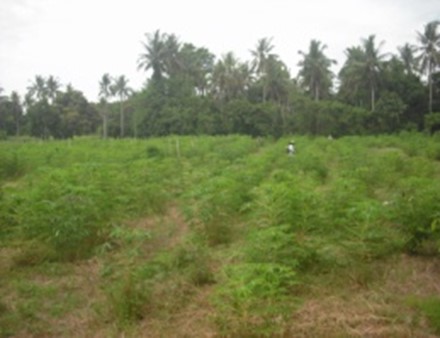
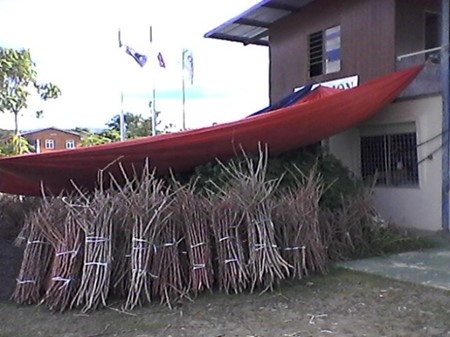

Cassava Chips Processing
The production of cassava chips involves a straightforward process:
- Harvesting: Farmworkers begin by harvesting the mature cassava roots from the fields.
- Transportation: The harvested cassava roots are transported to the processing pad, where further steps will take place.
- Slicing: A steel shredder is employed to slice the cassava roots into small, uniformly sized pieces. This shredding process is critical for ensuring consistency in the final product.
- Drying: The sliced cassava pieces are then subjected to mechanical drying. This drying process is essential to reduce the moisture content of the cassava chips to approximately 13%. Lowering the moisture content is crucial for preserving the quality and shelf life of the chips.
- Packaging: Once the desired moisture level is achieved, the cassava chips are ready for packaging. They are typically packed in suitable containers for transportation and storage.
- Storage: The packaged cassava chips are stored in a suitable facility to maintain their quality and prevent moisture reabsorption.
- Delivery: Finally, the cassava chips are transported to the animal feed mill industry, where they are utilized as a key ingredient in animal feed production.
In general, the conversion rate from fresh cassava roots to cassava chips is approximately 2.5 metric tons of fresh roots to produce 1 metric ton of chips. This efficient processing method ensures that cassava chips are readily available for various applications, including the animal feed industry.
5.4 Cleaning 5.5 Cutting 5.6 Drying
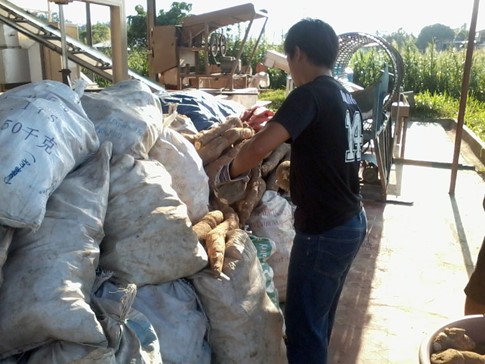
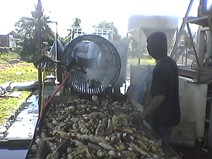
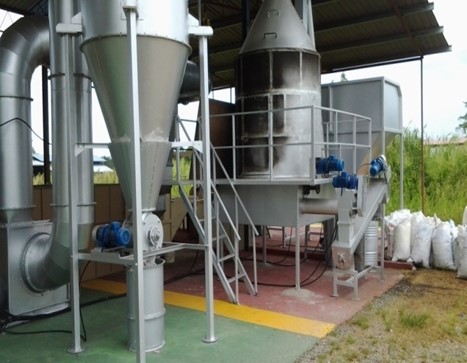
5.7 Packaging 5.8 Storage 5.9 Delivery
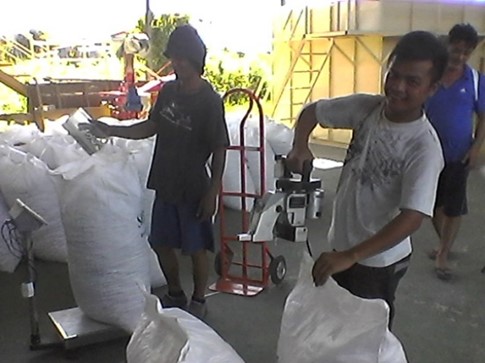
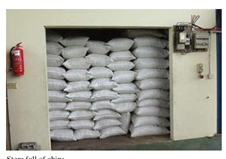

Operation images source: Author
6.0 Financial Implications
6.1 Investment segments
The investment in cassava cultivation and processing can be divided into three main segments:
Upstream: Planting, Crop Management, and Harvest
- This segment involves activities related to the cultivation of cassava, including planting, crop care, and the harvesting of cassava roots.
Midstream: Peeling, Cutting, Drying, Processing, Packaging, Storage, and Transportation
- The midstream segment encompasses various processes, such as peeling and cutting cassava roots, drying the sliced pieces, further processing them into chips, packaging the final product, storing it, and managing the transportation logistics.
Downstream: Starch Derivative Processing
- The downstream segment focuses on the processing of cassava into starch derivatives, such as malto dextrin, sorbitol, and fructose, which have applications in various industries.
Phase 1:
- Phase 1 of the investment plan involves the initial stage of setting up cassava cultivation and processing facilities. The goal is to plant 288,000 hectares of cassava and establish processing factories capable of producing 4.15 million metric tons of cassava chips. These chips will be primarily supplied to the animal feed millers in Malaysia.
Stage 1:
- Within Phase 1, Stage 1 is a critical milestone. It focuses on the development of a 20,000-hectare cassava plantation and the construction of a dedicated factory to produce 288,000 metric tons of cassava chips. This stage specifically caters to the animal feed millers in Sabah, Malaysia.
Return:
- A well-managed cassava plantation coupled with an efficient chips processing factory can yield a promising return on investment. It is anticipated that a return of 40% can be achieved from the second year onwards, indicating the potential for sustainable profitability in this venture.
Total Investment:
- 288,000 hectares of cassava cultivation with associated factories.
- Cost per hectare: US$2,000.
- Total Investment = 288,000 hectares x US$2,000/hectare = US$576 million.
Stage 1 Investment:
- 20,000 hectares of cassava cultivation with associated factories.
- Cost per hectare: US$2,000.
- Stage 1 Investment = 20,000 hectares x US$2,000/hectare = US$40 million.
These figures represent the initial capital required for the cassava cultivation and processing project, with Stage 1 focusing on the development of a 20,000-hectare cassava plantation and associated facilities.
6.2 Production cost
The production cost for cassava chips is a critical component to consider:
- Total: Producing 4.15 million metric tons of cassava chips at an average local production cost of US$160-180 per metric ton amounts to approximately US$747 million per year.
- Stage 1: For the initial 0.288 million metric tons of cassava chips produced in Stage 1, the estimated cost is US$51.84 million per year.
6.3 Prices and Revenues
Revenue is generated based on the sale of cassava chips:
- Total Revenue: Selling 4.15 million metric tons of cassava chips at a price of US$265 per metric ton results in total revenue of US$1.1 billion.
- Stage 1 Revenue: The sale of 0.288 million metric tons of cassava chips from Stage 1, priced at US$265 per metric ton, generates revenue of US$76 million.
Price Trends:
- In 2020, cassava chip prices ranged from US$219-268 per metric ton (FOB Thailand).
- In 2021, cassava chip prices were in the range of US$265-270 per metric ton (FOB Thailand).
- Over the last four years, cassava chip prices have fluctuated within the range of US$210-270 per metric ton.
- In 2020, malto dextrin was priced between US$450-490 per metric ton (China domestic price).
- In 2021, the price of malto dextrin surged to US$766 per metric ton (China domestic price).
- In 2020, corn prices ranged from US$143-198 per metric ton (FOB USA Gulf Ports).
- In 2021, corn prices reached US$267 per metric ton (FOB USA Gulf Ports) and varied from US$227-312 per metric ton in Malaysia.
6.4 Financial returns

Agricultural and farmland investment differs; some lose money, the majority earned a return between 8-12% per year and as high as 40%. In 2019, the average IRR for Asia was 12%. The rate of return depends on the cost of production, price of cassava and the competitor’s corn price.
The following financial models provide snapshots of the industry returns.
Case 1: A 125-hectare cassava plantation and factory in Borneo with an investment of US$0.4 million was estimated to result in a return of 40% from year 2 onwards with a payback period of 4 years.
Case 2: An investment of 10,000 hectares with a capital investment of US$25 million showed an IRR of over 37%.
2019 Financial Income of listed cassava dried chips companies.
Company Revenue Net Income Asia Cassava Resources US$208 million US$3.3 million Thai Wah US$235 million US$2.2 million Green Leader Holdings US$121 million US ($89) million Camfarm (Hong LH) US$22.1 million US$1.3 million Source: https://www.wsj.com/market-data/quotes/company-list
6.5 Source of Funding
Funding for the cassava cultivation and processing project can be sourced from various avenues:
1. Strategic investors:
- New investor: Project leader with a focus on business and financial management focus
- Financier: Agriculture private equity groups
- Cassava operator: International cassava plantation and chips operators
- Animal feed miller: Malaysia animal feed mill groups.
2. Private equities and investors:
- Agriculture based funds have witnessed significant growth, with over 300 funds by 2019, compared to seven in 2004.
- Approximately 44% of the agriculture investments are from the pension fund.
- Asia accounted for 111 funds with a combined capital of US$41 billion.
ADM Capital ADQ Aegon Asset Management AgFunder Amerra Capital APG Asset Management Beijing Agricultural Investment Black Rock Capital Research & Management Carlyle Group Cerea Partners China Resources Capital CITIC Agriculture CMIA Capital Partners COFCO Capital Dimensional Fund Advisors EBG Capital Equilibrium Fidante Partners Fidelity Future Planet Capital Geode Capital Management Hillhouse Capital Hosen Capital International Farming Corporation Jardine Matheson KKR LSV Asset Management M&G Investment Management Mandala Capital Manulife Investment Management MetLife Investment Management Navis Capital Partners NCH Capital New Hope Group Norfund Norges Bank Investment Management Northern Trust Investments Northstar Group Nuveen Olympus Capital Asia Paine Schwartz Partners Prime Value Proterra Investment Partners PSP Investments Robobank Rohatyn Group SEAF SSgA Funds Management Stafford Capital Partners State Farm Investment Management Syngenta Ventures TAEL Partners Talis Capital Tate & Lyle Temasek Threadneedle Asset Management TPG Capital T. Rowe Price Associates UBS Asset Management Vanguard Group Versus Capital VinaCapital VMG Partners Wellington Management
3. Other financial support to the cassava industries:
ACIAR (Australian Centre for International Agricultural Research) ADB BlueOrchard Finance Capria Fund CASA CDC Group CGIAR CIAT CIRAD DADTCO (Dutch Agricultural Development & Trading Company) EBRD, Emerging Markets Impact Investment Fund trust (EMIIF) FAO Ford Foundation Future Fund Guangxi State Farm Grow Asia IDRC IFAD (International Fund for Agricultural Development) IFC IITA NRI Rockefeller Foundation Triodos Investment Management UNDP USAID Green Invest Asia
4. Consultants, development and funding managers for the cassava and agriculture industries:
AFR Atlas Funds Management BCG (Boston Consultant Group) Big Idea Venture Deloitte Duxton Asset Management EBG Capital Ernst & Young Global AgInvesting KPMG HighQuest Consulting Inconfin, Investopedia LMC International McKinsey & Company Milltrust Agricultural Investments Oakland Institute One Investment Group Origin Capital Group PitchBook Preqin PWC Rabo Equity Advisors ROC Partners Southern AG Management Valoral Advisors Westchester Group
The unique business attributes of this cassava cultivation and processing venture present compelling reasons for private equity fund investors to consider this opportunity:
- Cassava Chips as Corn Replacement: The project aims to replace corn imports in Malaysia’s animal feed industry, with strong backing from the Malaysian Government and immediate demand from local animal feed millers.
- Diverse Product Lines: Beyond cassava chips, the project includes downstream starch derivatives, broadening its product portfolio and market reach.
- Year-Round Harvesting and Stable Cash Flow: Cassava chips can be harvested and processed throughout the year, ensuring a stable and continuous cash flow.
- Cost Advantages in Borneo: Borneo Island offers cost advantages in terms of capital, production, land, labor, and energy, making it an attractive location for this venture.
- Competitive Edge Over Imports: Imported animal feed, including corn and cassava chips, faces higher production costs, logistics charges, and import duties, giving locally produced cassava chips a competitive edge.
- Plasma System/Contract Farming Model: The project follows a plasma system/contract farming model, where the investor oversees cassava chips processing factories strategically located, and local farmers provide raw cassava roots at agreed contract prices.
- Strong Management Team: A robust management team with a proven track record is in place, providing confidence in the project’s success.
- Recurring Revenues and Growth: The project’s recurring revenues and growth potential contribute to achieving its financial and business objectives.
6.6 The Real Opportunity: Downstream Industries
While cassava chips for the animal feed industry offer excellent cash flow and profit margins, the true “big bikkie” lies in the downstream industries. South-East Asian markets, known for their consumption of products like Milo, Ovaltine, chocolate drinks, three-in-one coffee, fructose cordial, kaya toast, and noodles, represent a substantial market for cassava starch derivatives. With a regional population of over 655 million, these products have the potential to generate over US$10 billion in annual consumption. This downstream expansion presents a significant growth opportunity and a path to substantial returns on investment.
7.0 Management Team
7.1 Key Management Team
- Mentor:
Mentors are visionary pioneers and industry leaders with a vast global network. They provide invaluable guidance and inspiration.
- Coaches:
Coaches are mission-oriented industry experts who offer practical solutions to challenges, ensuring the team stays focused on its objectives.
- Partners:
1. A project leadership group with experience in the plantation, processing, R & D and international exposure to the cassava industry.
2. A reputable finance manager with access to private equity funding in the Asia Pacific agriculture segment.
3. A credible local investor with land procurement capabilities, network of domestic animal feed millers, financial incentives and business support from the government.
Here are some examples of the global top leaders of the cassava industry. Their names are included as a tribute to honour their vision, successful mission, and contribution to the industry.
- Simon Bentley
- Peter Cain
- Dr. Hernan Ceballos
- Dr. Reinhardt Howeler
- Dr. Imran Malik
- Dr. Jonathan Newby
- Professor Chareinsak Rojanaridpiched
- Chaiwat Sowcharoensuk
- Dr. SL Tan
- Dr. Jens Thomsen
There are many other outstanding professionals and captain of the industry. The readers are encouraged to conduct further research on their own management team players.
7.2 Key Management Team Model
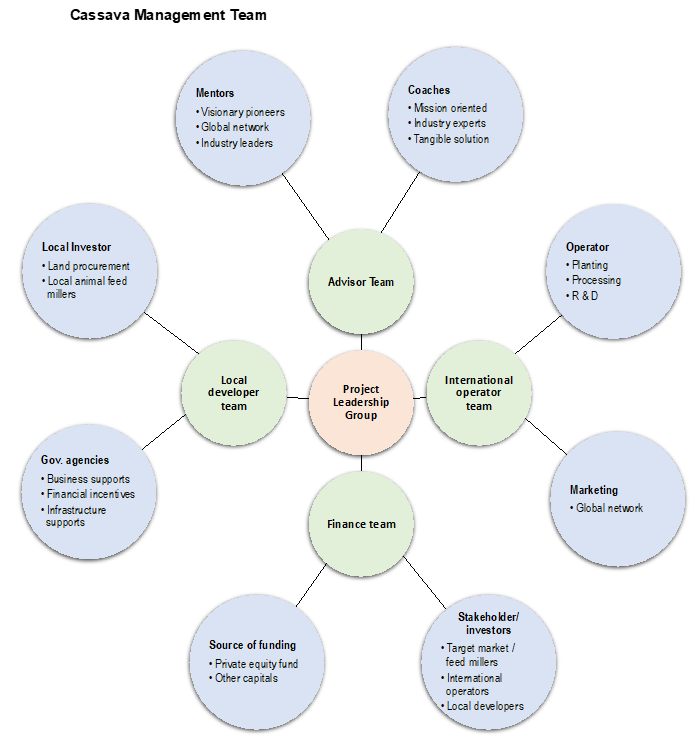
8.0 Unique Business Model
The unique business model for this cassava cultivation and processing venture incorporates key elements that set it apart and position it for success:
8.1 Successful Track Record
- The business model draws inspiration from the successful Thailand cassava industry, which has effectively implemented upstream, midstream, and downstream production methods.
- Strategic alignment with Thailand operators with a proven track record enhances overall performance, productivity, and reduces the learning curve.
- Long-term leases for the plantation serve as anchor tenant agreements, ensuring a stable supply of raw materials.
- A well-managed cassava chip mill can generate a remarkable 40% profit margin within the value chain.
- The mill also engages with surrounding smallholders and traders through the plasma system, providing additional income to farmers and promoting crop diversification away from monocropping.
8.2 Entry Model
- The entry model involves leasing existing idle land, reducing the initial capital requirements.
- Significant investments will be directed towards planting, harvesting, and processing machinery.
- Strategic partnerships with the government, existing corn traders, and feed millers facilitate access to land banks and the target market.
8.3 Unique Business Model
- The venture’s unique business model centers on addressing food security concerns, a top priority for sovereign nations like Malaysia.
- Borneo Island is strategically positioned to host upstream and midstream operations.
- The model entails owning both farmland and processing factories, establishing a fully integrated system spanning from the farm gate to the retail market.
- The plasma system ensures full procurement of additional raw materials and expands sales to target animal feed millers, securing sales partnerships and market access.
This unique and holistic approach aligns with national priorities and positions the project for long-term success while contributing to food security and economic diversification.
9.0 Key Success Factors & Risk Mitigation
Ensuring the success of the cassava cultivation and processing venture involves identifying key success factors and implementing strategies to mitigate potential risks.
9.1 Key Success Factors
- Secure Target Market Feed-Millers: Establishing strong partnerships with target animal feed millers and securing their commitment to purchase the end product is essential for market stability and revenue generation.
- Government Support: Strategic support from the Malaysian government is crucial. It not only facilitates investment in Borneo for food security in the animal feed industry but also helps diversify monocropping practices, reducing ecological risks.
- Secure Source of Funding: Ensuring a secure and sustainable source of funding, with the capacity for scalable upgrades and expansion, is vital for project continuity and growth.
- Strong Management Team: Having a capable and experienced management team with industry networks is a fundamental factor in driving operational excellence and business growth.
9.2 Risk
- Labor-Intensive Industry: The cassava industry relies heavily on labor-intensive processes, which can pose challenges in terms of efficiency and costs.
- Limited Technology for Harvesting: Limited modern technology and equipment options for harvesting cassava can impact productivity and increase operational complexities.
- Commodity Price Fluctuations: The fluctuation of competitive commodity prices, particularly for corn, can affect the profitability of cassava chips as a substitute.
- Variety Selection and Availability: The selection and availability of adapted high-yielding cassava varieties can impact overall production and product quality.
9.3 Risk Mitigation
- Technological Advancements: Forming strategic alliances with agricultural machinery manufacturers can lead to investments in new technology that improves planting and harvesting performance, reducing reliance on labor-intensive practices.
- Contractual Commitments: Implementing joint venture investments in the upstream and midstream industries can establish contractual commitments to production and maintain stable pricing. This strategy helps mitigate the risks associated with commodity price fluctuations.
- Research and Development: Establishing a global network with scientists and researchers can aid in the continuous improvement of cassava varieties. This includes developing high-yield, high-nutritive value varieties that are resistant to diseases and pests. Research-driven efforts can enhance crop resilience and productivity.
By addressing these key success factors and proactively mitigating risks, the cassava cultivation and processing venture can position itself for sustainable growth and success in the agricultural industry.
10.0 Exit Strategy
Planning for an effective exit strategy is a critical aspect of any investment venture. Here’s an overview of potential exit options, benefits for new investors, and strategies for success:
10.1 Forms of Exit
- IPO (Initial Public Offer): This involves taking the company public, allowing private investors to sell their shares to the public.
- M&A (Merger & Acquisition): The company may be acquired by another company in a similar industry.
- Sale: Private investors can sell their stakes to another private equity firm.
- Buyback: The management team of the company may choose to buy back the equity stake from private investors.
10.2 Benefits for New Investors
- Market: The venture targets the animal feed millers in Malaysia, offering a substantial market.
- Revenue: New investors can expect recurring revenue with planned future growth.
- Price: Stable income from cassava chips is competitive compared to corn import prices.
- Risk: Secure demand and a well-structured price system reduce exposure to commodity price fluctuations.
- Product: Expansion into downstream starch derivatives presents opportunities to tap into high-demand markets.
- Opportunity: The venture’s ability to produce Malto dextrin offers an additional revenue stream.
- Exit: The exit plan is set after the third year when production cycles and cash flow are stable. Longer investment periods generate greater revenue and higher returns.
10.3 Attraction of the Business to New Investors
- Market: Acquiring the business allows new investors to capture additional market share in Malaysia’s animal feed industry.
- Cost: An acquisition provides opportunities to streamline operations, reduce costs, and enhance overall performance.
- Price: The pricing structure increases annually, potentially offering higher returns for investors.
- Leadership: New investors can bring fresh insights and strategies to the business.
- Distribution: Acquiring the venture provides access to new markets, products, and distribution channels.
- Revenue: The venture’s expansion into Malto dextrin and downstream products offers additional revenue streams.
10.4 Winning Strategy
- Strategy: Implement disciplined management practices and ensure profitable operations to achieve sound financial and business goals before the exit.
- Win-Win: Effective communication with potential new investors is key to showcasing the value-added investment opportunity. Providing a high reward to the original investors can enhance loyalty and trust in the venture.
A well-planned exit strategy, coupled with a compelling value proposition for new investors, sets the stage for a successful transition and continued growth of the venture.
Pre-IPO Strategies
